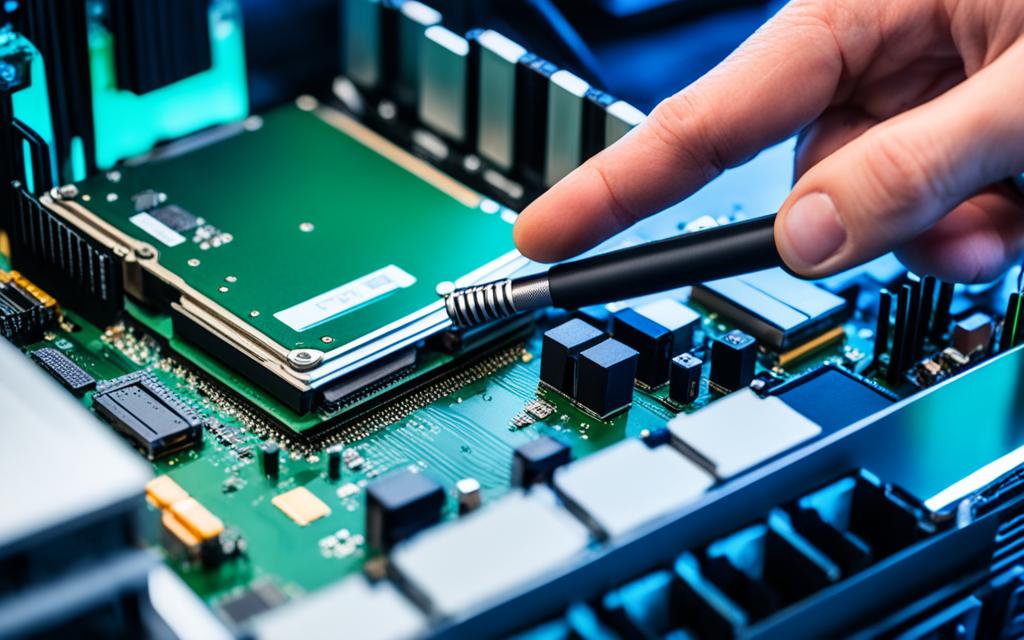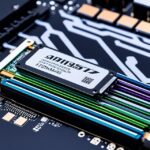Table of Contents
Formatting a new NVMe SSD properly is crucial for the best computing experience. It enhances performance and reliability, making sure it works well with your operating system. This step prepares your drive for better reading and writing operations. Following this guide will make setting up your NVMe SSD easier and help it perform at its best. Before starting, don’t forget to back up your important data1.
Key Takeaways
- Formatting NVMe SSDs is essential for compatibility and optimal performance.
- Prior to formatting, ensure you back up important data stored on the drive.
- Choose between quick formatting and full formatting based on your needs.
- Utilise tools like EaseUS Partition Master for effective SSD optimisation.
- Post-formatting, enabling TRIM can enhance the longevity and efficiency of your SSD.
Understanding NVMe Technology
Adopting new data storage solutions brings big improvements in speed with NVMe tech. This new protocol boosts how well solid-state drives (SSDs) work. It makes storage devices and computers talk faster and more efficiently.
What is NVMe?
NVMe stands for Non-Volatile Memory Express. It’s a speedy interface made for SSDs. It uses PCIe sockets, making data transfer 25 times quicker than old SATA connections. This changes how storage talks to computers2. NVMe also executes commands twice as fast as old AHCI drivers. This means tasks that need lots of data can go really fast3.
Benefits of Using NVMe SSDs
Switching to NVMe SSDs has big perks. These drives are faster in reading and writing than older SSDs and HDDs. This gives you faster boot times and quick file access. For example, PCIe 4.0 NVMe drives can read at speeds up to 7,300MB/s. That’s way faster than SATA III’s max of 600MB/s2. NVMe also beats AHCI in IOPS by up to 900%, reaching more than 1 million IOPS2.
NVMe’s efficiency leads to less waiting, with a super low latency of only 2.8 microseconds. That’s faster than the 6 microseconds of AHCI2. It also handles lots of commands at once, with space for 64K command queues. Each queue can manage 64K commands simultaneously, unlike AHCI’s lower limit2.
In short, NVMe’s benefits boost system performance and efficiency. This is great for intense tasks like gaming and data analysis. Moving to NVMe SSDs is a key move towards the future of fast storage. It makes them vital for any system that needs speed2.
Preparing to Format Your NVMe SSD
Getting your NVMe SSD ready for formatting boosts its performance. To start, preparing an NVMe SSD for formatting means doing important things like saving your data elsewhere. You also need to choose the best format option for your needs.
Backup Important Data
It’s crucial to back up your files before formatting. You can use trusted backup software or move data to an external drive or the cloud. This step is important because formatting clears everything on the SSD4.
Making regular backups should be a key part of looking after your data.
Choose Between Quick and Full Format
Deciding on the right format type matters a lot. A quick format removes files fast, usually in 45 seconds to 1 minute5. It’s good for most needs. But, a full format takes more time as it wipes all data, making it hard to recover. This method is better if you want to keep data secure6. So, you can choose based on whether you prefer speed or thoroughness.
| Formatting Type | Time Required | Data Recovery | Best For |
|---|---|---|---|
| Quick Format | 45 seconds to 1 minute | Possible | General use, quick resets |
| Full Format | Several minutes (varies by size) | Highly unlikely | Sensitive data management, thorough cleaning |
These step-by-step actions prepare your NVMe SSD perfectly for formatting. By following them, you can make the most out of your SSD546.
How to Format New NVMe SSD
If you’re looking to format a new NVMe SSD, you have some choices. Each option has its own benefits. Let’s look at three ways: using EaseUS Partition Master, Disk Management, and Command Prompt. These will get your drive ready for top-notch performance.
Using EaseUS Partition Master
EaseUS Partition Master makes formatting easy. Just pick your drive, choose NTFS or FAT32 as the file system, and start formatting. It’s great for those who prefer straightforward steps without the hassle of complex disk management.
Formatting via Disk Management in Windows 10/11
Disk Management in Windows helps format an NVMe drive quickly. Right-click the drive, select “format,” and choose NTFS or exFAT. You can also choose a quick format. This way hardly affects stored data, unlike a full format that removes7everything.
Command Prompt Formatting
Advanced users might like formatting with Command Prompt. Use commands diskpart and format to do the job precisely. This method is ideal for those comfortable with terminal commands, offering detailed control over formatting.
| Formatting Method | Ease of Use | Data Preservation | File One system Options |
|---|---|---|---|
| EaseUS Partition Master | High | Varies (depends on option selected) | NTFS, FAT32, exFAT, APFS, Ext4 |
| Disk Management | Moderate | 0% data loss (Quick Format) | NTFS, exFat |
| Command Prompt | Low | Depends on commands used | NTFS typically |
Knowing these formatting choices helps you pick the best one for your NVMe SSD. You can choose an option that fits your needs and preferences perfectly876.
Post-Formatting Steps for Optimisation
After you format your NVMe SSD, it’s crucial to take steps that boost its performance and life. By following these practices, users gain a lot from the speed and reliability of SSD technology.
Enabling TRIM for SSD Maintenance
Turning on the TRIM command is essential for keeping your SSD in good shape. It lets your system tell the SSD which data blocks it can skip. This helps the drive manage its space better, boosting performance and lifespan. Without TRIM, an SSD’s speed could drop over time as it fills with useless data blocks. A maintained SSD lets users enjoy fast and efficient storage.
Regular Drive Health Checks
It’s vital to check your SSD’s health often to keep it running well. Tools like NVMe-CLI give useful data on the SSD’s condition, checking temperature, endurance, and errors. Regular checks can spot and fix problems early. This ensures your SSD stays in top condition, avoiding any drop in performance. For tips on SSD optimisation, see this guide9.
| Monitoring Aspect | Command | Description |
|---|---|---|
| SMART Attributes | nvme smart-log | Monitors SSD health including temperature and endurance levels. |
| Drive Self Test | nvme device-self-test | Performs a health check and provides pass/fail results. |
| Identiy SSDs | nvme list | Lists attached NVMe SSDs along with critical details. |
| Erase SSD Data | nvme sanitize | Securely erases data, supporting data protection protocols. |
Source Links
- https://www.easeus.com/partition-master/how-to-format-nvme-ssd.html – How to Format NVMe SSD in Windows 10/11 [Full Guide]
- https://www.kingston.com/en/ssd/what-is-nvme-ssd-technology – What is NVMe SSD technology? – Kingston Technology
- https://www.techtarget.com/searchstorage/definition/NVMe-non-volatile-memory-express – What Is NVMe? Benefits, Uses and Form Factors Explained | TechTarget
- https://www.diskpart.com/articles/format-nvme-drive-windows-10-0725.html – How to Format NVMe Drive in Windows 10?
- https://www.easeus.com/partition-master/how-to-format-m2-ssd.html – How to Format M.2 SSD? [Easy Instructions]
- https://www.crucial.com/articles/about-ssd/how-to-format-a-solid-state-drive – How to Format a Solid State Drive (SSD)
- https://www.minitool.com/backup-tips/how-to-format-an-nvme-ssd.html – How to Format an NVMe SSD? An Easy and Safe Guide for You
- https://www.kingston.com/en/blog/personal-storage/how-to-format-ssd – How to Format Your SSD
- https://www.partitionwizard.com/partitionmagic/how-to-format-ssd.html – 3 Different Ways to Free Format SSD with No Harm to SSD – MiniTool Partition Wizard
- https://byteshiva.medium.com/formatting-an-nvme-ssd-in-mx-linux-a-step-by-step-guide-681debf02299 – Formatting an NVMe SSD in MX Linux: A Step-by-Step Guide








